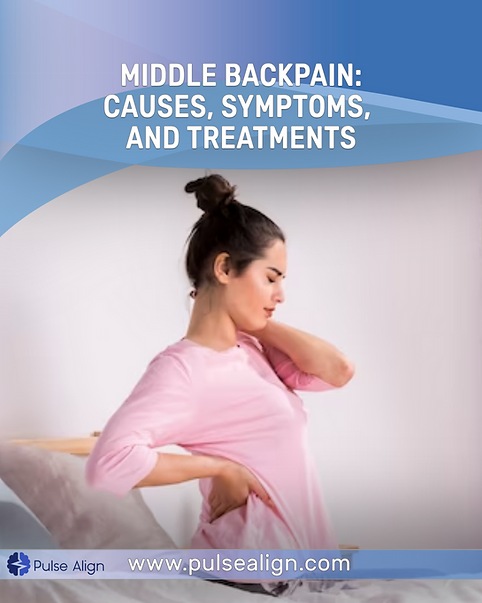Middle back pain, a prevalent and often overlooked discomfort, can significantly impact our daily lives. Whether it’s a dull ache or a sharp pain, understanding the causes, symptoms, and effective treatments is crucial for finding relief and preventing future issues. In this comprehensive guide, we will delve into the intricate details of middle back pain, exploring potential causes, recognizing symptoms, and discussing advanced treatments. Additionally, we will shed light on the revolutionary approach of Pulse Align, emphasizing the importance of addressing root causes for a natural return to well-being.
Approximately 80% of Americans encounter back issues at least once or more throughout the year. About 8% of individuals aged 18 and older suffer from chronic back pain, severely restricting their daily activities.
Understanding Middle Back Pain
Anatomy of the Middle Back
To comprehend middle back pain, it’s essential to grasp the anatomy of the region. The middle back, also known as the thoracic spine, consists of twelve vertebrae (T1-T12) that connect to the ribs, forming the upper and middle parts of the spine. Muscles, ligaments, and tendons surround and support these vertebrae, contributing to the overall stability and mobility of the spine.
Causes of Middle Back Pain
- Poor Posture
One of the leading causes of middle back pain is poor posture. Prolonged periods of sitting or slouching can strain the muscles and ligaments in the thoracic spine, leading to discomfort and pain.
- Muscular Imbalances
Muscular imbalances, where certain muscles are weaker or tighter than others, can contribute to middle back pain. This imbalance can result from poor exercise habits, lack of physical activity, or injury.
- Herniated Discs
Intervertebral discs act as cushions between the vertebrae, providing flexibility and shock absorption. When a disc herniates, the inner gel-like material can leak out, pressing on nearby nerves and causing middle back pain.
- Osteoarthritis
Osteoarthritis, a degenerative joint disease, can affect the thoracic spine, leading to the breakdown of cartilage between the vertebrae and causing pain and stiffness.
Recognizing Symptoms of Middle Back Pain
Distinguishing Characteristics
Middle back pain can manifest in various ways, making it essential to recognize the distinctive characteristics of the discomfort. Patients often describe aching, stiffness, or sharp pain localized in the middle of the back. The pain may worsen with movement, deep breathing, or certain body positions.
Additional Symptoms
In addition to localized pain, individuals experiencing middle back pain may encounter other symptoms, including muscle spasms, limited range of motion, and, in severe cases, radiating pain into the arms or legs. Identifying these symptoms aids in understanding the underlying causes and determining the most effective course of treatment.
Conventional Treatments for Middle Back Pain
Physical Therapy
Physical therapy plays a pivotal role in treating middle back pain by addressing muscular imbalances, improving posture, and enhancing overall spinal health. Therapeutic exercises and stretches can promote flexibility and strength, alleviating discomfort and preventing future issues.
Pain Medications
Over-the-counter or prescription medications may be recommended to manage pain and inflammation associated with middle back pain. However, these medications often provide temporary relief without addressing the root causes of the discomfort.
Invasive Procedures
In severe cases, healthcare professionals may consider invasive procedures such as injections or surgery to alleviate middle back pain. While these interventions can be effective, they come with potential risks and may not guarantee a long-term solution.
The Pulse Align Approach: Addressing Root Causes for Lasting Relief
Understanding Pulse Align
Pulse Align represents a groundbreaking approach to middle back pain by prioritizing the identification and resolution of root causes. Unlike conventional treatments that primarily target symptoms, Pulse Align aims to restore normal function by addressing underlying issues contributing to the pain.
Holistic Assessment
The Pulse Align system begins with a comprehensive and holistic assessment, examining factors such as posture, muscular imbalances, and lifestyle habits. By understanding the patient’s unique circumstances, Pulse Align tailors a personalized treatment plan to address the specific root causes of their middle back pain.
Benefits of Pulse Align
- Individualized Care
Pulse Align recognizes that each individual is unique, and their middle back pain may result from a combination of factors. The personalized approach ensures that treatment is tailored to the specific needs of the patient, maximizing effectiveness.
- Non-Invasive Techniques
Unlike invasive procedures, Pulse Align employs non-invasive techniques such as chiropractic adjustments, therapeutic exercises, and lifestyle recommendations. These methods focus on restoring normal function without the risks associated with surgery or injections.
- Long-Term Relief
By addressing root causes, Pulse Align offers the potential for long-term relief from middle back pain. Rather than masking symptoms with medications, this holistic approach aims to create lasting improvements in spinal health and overall well-being.
Holistic Insights
Pulse Align encourages patients to adopt a holistic perspective on health, considering factors such as nutrition, stress management, and overall lifestyle. By addressing these aspects, individuals can contribute to their well-being and support the long-term success of the Pulse Align approach.
Lifestyle Changes for Improved Well-Being
Ergonomics and Posture
Simple lifestyle changes, such as improving ergonomics and maintaining proper posture, can significantly contribute to the prevention and management of middle back pain. Pulse Align emphasizes the importance of integrating these changes into daily life for sustained benefits.
Physical Activity
Regular physical activity is crucial for maintaining spinal health and preventing middle back pain. Pulse Align guides suitable exercises and activities tailored to individual needs, promoting overall well-being.
Conclusion: Inviting Readers to Explore Pulse Align for a Natural Return to Normal Function
In conclusion, middle back pain is a complex issue with various potential causes, symptoms, and treatments. While conventional approaches may offer temporary relief, the Pulse Align system stands out for its focus on addressing root causes for a natural return to well-being. By embracing a holistic assessment and personalized care, Pulse Align offers the potential for long-term relief and improved spinal health. Readers are invited to consider lifestyle changes and explore the benefits of Pulse Align for a holistic approach to middle back pain and overall well-being.
Reference
- Johansson, M. S., Jensen Stochkendahl, M., Hartvigsen, J., Boyle, E., & Cassidy, J. D. (2017). Incidence and prognosis of mid‐back pain in the general population: a systematic review. European Journal of Pain, 21(1), 20-28.
As the visionary CEO of Pulse Align, François is dedicated to transforming the landscape of pain management and posture health. With a deep-rooted passion for innovation and a commitment to excellence, François leads the team in developing cutting-edge solutions that empower individuals to live healthier, pain-free lives. Under his leadership, Pulse Align has become a beacon of hope and support for those navigating postural-related issues and chronic pain. François brings a wealth of experience in neuromodulation and patient management technologies, combining strategic insight with a compassionate approach to address the unique challenges faced by each individual.



